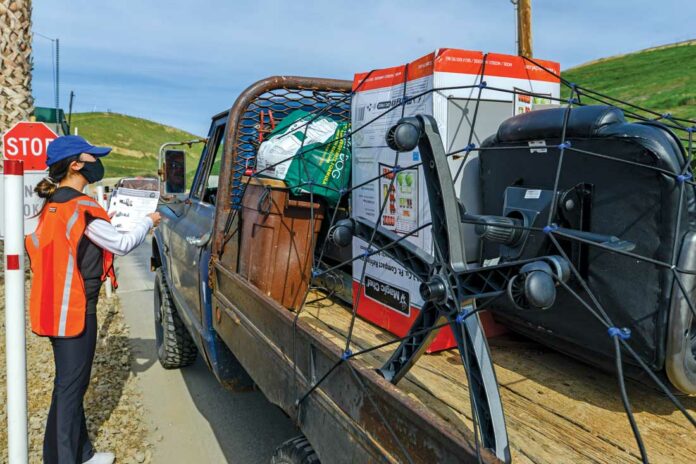
The public comment period is underway for the draft Environmental Impact Report on the proposed expansion of the John Smith Road Landfill—a project that would more than quadruple the size of the local 95-acre landfill.
The expansion of the waste disposal facility, located at 2650 John Smith Road southeast of Hollister, is proposed on a 388-acre property adjacent to the existing landfill to the west, north and east, according to project plans presented by San Benito County. The project proposes using this land to dispose of and store commercial and household waste for the next 50 years, and increasing the maximum daily intake of garbage to 2,300 tons. John Smith Road Landfill currently accepts up to 1,000 tons of waste per day.
The expansion is proposed by San Benito County, which owns the vast majority of the landfill site, and the facility’s operator, Waste Solutions of San Benito LLC. On July 15, the county released a draft EIR of the JSRL expansion proposal, and invited the public to submit input, ask questions or provide commentary during a 45-day public review period.
Comments from the public can be submitted in writing or by email before 5pm Aug. 29, to Stan Ketchum, Project Planner, San Benito County Resource Management Agency, 2301 Technology Parkway, Hollister CA 95023; or sk******@**sb.us.
A paper copy of the 485-page draft EIR is available for review at the San Benito County Resources Management Agency offices at 2301 Technology Parkway during regular business hours, 8am-5pm Monday-Friday. The document can also be viewed on the county’s website at cosb.us.jsrlexpansion.
County staff will also accept verbal comments on the draft EIR at a number of public hearings coming up over the next few weeks, including a public town hall meeting about the project at 6:30pm Aug. 22 at the Veterans Memorial Building, 649 San Benito Street in Hollister. The county’s planning commission and board of supervisors will also hold public hearings on the JSRL expansion and draft EIR on dates to be determined, according to the county’s public notice of the review period.
The 388-acre property proposed for the JSRL expansion is currently used for cattle grazing and is zoned Rangeland and Agricultural, according to the draft EIR. The expansion would require a General Plan amendment to change the land use classification to Quasi Public.
The proposed project also requires the approval of a conditional use permit, among other permits from San Benito County.
Some residents of San Benito County have already begun to voice their input on the JSRL expansion proposal. Members of the group Don’t Dump on San Benito, which is opposed to the landfill expansion, have organized a “community forum” on the draft EIR for Aug. 2 at The Garden Shoppe in Hollister.
Maureen Nelson and Neal Anderson—both members of Don’t Dump on San Benito—said in recent comments to this newspaper that one of their chief concerns is the amount of garbage entering JSRL from outside San Benito County, and the impact this regional traffic has on local roads and neighborhoods.
From 2016-2020, at least 79% of all non-recyclable waste that entered JSRL each year was from outside the county, with the rest coming from San Benito residents, according to the draft EIR.
Until this year, the county has gained about $1.4 million revenues from out-of-county disposal fees at JSRL, according to county staff. Nelson doesn’t think that’s enough to offset the impact of more out-of-county dump traffic.
“Although the county supervisors want to tell us this is a stream for money, the costs associated with this landfill and (its) operation, and degradation to the environment are greater than any fees received by the county,” Nelson said.
Since April 1, the county’s landfill no longer accepts out-of-county waste due to its shrinking storage capacity and need to leave enough room for local garbage. The landfill reached its 15-year in-county capacity threshold in March, triggering a contract clause with Waste Solutions that halts garbage flow from customers outside the county.
The draft EIR includes a detailed analysis of the project proposal, and a number of alternatives, and its effect on the natural, cultural, tribal and public resources that surround it.
After the 45-day public review period, the county’s EIR contractor will incorporate public input into a final EIR, which must be approved by the board of supervisors before any permits can be granted for the JSRL expansion.









